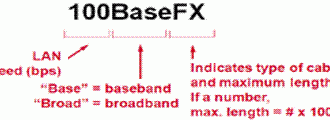This chart give you an idea of the range of Ethernet protocols including their data rate, maximum segment length, and medium.
Ethernet has survived as an essential media technology because of its tremendous flexibility and its relative simplicity to implement and understand. Although other technologies have been touted as likely replacements, network managers have turned to Ethernet and its derivatives as effective solutions for a range of campus implementation requirements. To resolve Ethernet’s limitations, innovators (and standards bodies) have created progressively larger Ethernet pipes. Critics might dismiss Ethernet as a technology that cannot scale, but its underlying transmission scheme continues to be one of the principal means of transporting data for contemporary campus applications.
The most popular today is 10BaseT and 100BaseT… 10Mbps and 100Mbps respectively using UTP wiring.
Let’s take a look at how Ethernet works.
Ethernet Operation
Let’s say in our example here that station A is going to send information to station D. Station A will listen through its NIC card to the network. If no other users are using the network, station A will go ahead and send its message out on to the network. Stations B and C and D will all receive the communication.
At the data link layer it will inspect the MAC address. Upon inspection station D will see that the MAC address matches its own and then will process the information up through the rest of the layers of the seven layer model.
As for stations B & C, they too will pull this packet up to their data link layers and inspect the MAC addresses. Upon inspection they will see that there is no match between the data link layer MAC address for which it is intended and their own MAC address and will proceed to dump the packet.
Ethernet Broadcast
Broadcasting is a powerful tool that sends a single frame to many stations at the same time. Broadcasting uses a data link destination address of all 1s. In this example, station A transmits a frame with a destination address of all 1s, stations B, C, and D all receive and pass the frame to their respective upper layers for further processing.
When improperly used, however, broadcasting can seriously impact the performance of stations by interrupting them unnecessarily. For this reason, broadcasts should be used only when the MAC address of the destination is unknown or when the destination is all stations.

